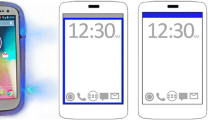Abstract
We describe the design of Grey, a set of software extensions that convert an off-the-shelf smartphone-class device into a tool by which its owner exercises and delegates her authority to both physical and virtual resources. We focus on the software components and user interfaces of Grey, highlighting the features of each. We also discuss an initial case study for Grey, in which we are equipping over 65 doors on two floors of office space for access control using Grey-enabled devices, for a population of roughly 150 persons. Further details of Grey, and this and other applications, can be found in a companion technical report.
We gratefully acknowledge support from the National Science Foundation grant number CNS-0433540, the U.S. Navy grant number N00014-04-1-0724, and the U.S. Army Research Office contract number DAAD19-02-1-0389.
Preview
Unable to display preview. Download preview PDF.
Similar content being viewed by others
References
Abadi, M.: On SDSI’s linked local name spaces. J. Computer Security (1998)
Abadi, M., Burrows, M., Lampson, B., Plotkin, G.D.: A calculus for access control in distributed systems. ACM Trans. Prog. Lang. and Sys. (September 1993)
Appel, A.W., Felten, E.W.: Proof-carrying authentication. In: Proc. 6th ACM Conference on Computer and Communications Security (November 1999)
Appel, A.W., Michael, N., Stump, A., Virga, R.: A trustworthy proof checker. J. Automated Reasoning 31(3-4), 231–260 (2003)
Balfanz, D., Dean, D., Spreitzer, M.: A security infrastructure for distributed Java applications. In: Proc. 21st IEEE Symposium on Security and Privacy (2002)
Bauer, L., Garriss, S., McCune, J.M., Reiter, M.K., Rouse, J., Rutenbar, P.: Device-enabled authorization in the Grey system. Technical Report CMU-CS-05- 111, Computer Science Department, Carnegie Mellon University (February 2005)
Bauer, L., Garriss, S., Reiter, M.K.: Distributed proving in access-control systems. In: Proc. 2005 IEEE Symposium on Security and Privacy (May 2005)
Bauer, L., Schneider, M.A., Felten, E.W.: A general and flexible access-control system for the Web. In: Proc. 11th USENIX Security Symposium (August 2002)
Beaufour, A., Bonnet, P.: Personal servers as digital keys. In: Proc. 2nd IEEE International Conference of Pervasive Computing and Communications (March 2004)
Blaze, M., Feigenbaum, J., Strauss, M.: Compliance checking in the Policy- Maker trust-management system. In: Proc. 2nd Financial Crypto Conference (1998)
Church, A.: A formulation of the simple theory of types. J. Symbolic Logic (1940)
Coquand, T.: An algorithm for testing conversion in type theory. In: Huet, G., Plotkin, G. (eds.) Logical Frameworks, pp. 255–280 (1991)
de Ipiña, D.L., Mendonça, P., Hopper, A.: TRIP: a low-cost vision-based location system for ubiquitous computing. Pers. and Ubiq. Comp. 6(3) (2002)
Dohrmann, S., Ellison, C.: Public key support for collaborative groups. In: Proc. First Annual PKI Research Workshop (April 2002)
Ellison, C., Frantz, B., Lampson, B., Rivest, R., Thomas, B., Ylonen, T.: SPKI certificate theory. RFC 2693 (September 1999)
Ellison, C.M., Frantz, B., Lampson, B., Rivest, R.: Simple public key certificate. Internet Engineering Task Force Draft (July 1997)
Goldberg, I.: Visual key fingerprint code (1996), Available at http://www.cs.berkeley.edu/iang/visprint.c
Halpern, J.Y., van der Meyden, R.: A logic for SDSI’s linked local name spaces. In: Proc. 12th IEEE Computer Security Foundations Workshop (1999)
Harper, R., Honsell, F., Plotkin, G.: A framework for defining logics. J. ACM 40(1), 143–184 (1993)
Lampson, B., Abadi, M., Burrows, M., Wobber, E.: Authentication in distributed systems: Theory and practice. ACM Trans. Comp. Sys. 10(4), 265–310 (1992)
Levin, R.: PGP snowflake. Personal communication (1996)
MacKenzie, P., Reiter, M.K.: Networked cryptographic devices resilient to capture. International Journal of Information Security 2(1), 1–20 (2003)
McCune, J.M., Perrig, A., Reiter, M.K.: Seeing-is-believing: Using camera phones for human-verifiable authentication. In: Proc. 2005 IEEE Symposium on Security and Privacy (May 2005)
Perrig, A., Song, D.: Hash visualization: A new technique to improve real-world security. In: Proc. 1999 Intern. Work. Crypto. Techn. and E-Comm. (July 1999)
Ramsdell, B.: Secure/multipurpose internet mail extensions (S/MIME) version 3.1: Message specification. RFC 3850 (July 2004)
Ravi, N., Stern, P., Desai, N., Iftode, L.: Accessing ubiquitous services using smart phones. In: Proc. 3rd Intern. Conf. Pervasive Comp. and Comm. (2005)
Rivest, R.L., Lampson, B.: SDSI—A simple distributed security infrastructure. Presented at CRYPTO 1996 Rumpsession (April 1996)
Rohs, M., Gfeller, B.: Using camera-equipped mobile phones for interacting with real-world objects. Advances in Pervasive Computing, pp. 265–271 (April 2004)
Scott, D., Sharp, R., Madhavapeddy, A., Upton, E.: Using visual tags to bypass Bluetooth device discovery. Mobile Comp. and Comm. Review 1(2) (January 2005)
Slawsby, A., Leibovitch, A.: Worldwide mobile phone 2004–2008 forecast update and 1H04 vendor shares (December 2004), http://www.idc.com/getdoc.jsp?containerId=32336
Wobber, E., Abadi, M., Burrows, M., Lampson, B.: Authentication in the Taos operating system. ACM Trans. Comp. Sys. 12(1), 3–32 (1994)
Author information
Authors and Affiliations
Editor information
Editors and Affiliations
Rights and permissions
Copyright information
© 2005 Springer-Verlag Berlin Heidelberg
About this paper
Cite this paper
Bauer, L., Garriss, S., McCune, J.M., Reiter, M.K., Rouse, J., Rutenbar, P. (2005). Device-Enabled Authorization in the Grey System. In: Zhou, J., Lopez, J., Deng, R.H., Bao, F. (eds) Information Security. ISC 2005. Lecture Notes in Computer Science, vol 3650. Springer, Berlin, Heidelberg. https://doi.org/10.1007/11556992_31
Download citation
DOI: https://doi.org/10.1007/11556992_31
Publisher Name: Springer, Berlin, Heidelberg
Print ISBN: 978-3-540-29001-8
Online ISBN: 978-3-540-31930-6
eBook Packages: Computer ScienceComputer Science (R0)




